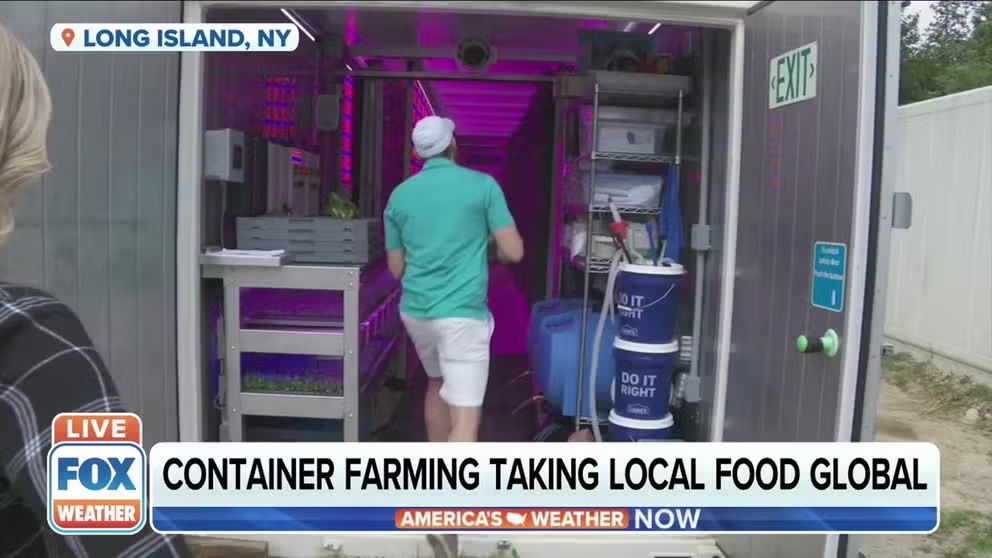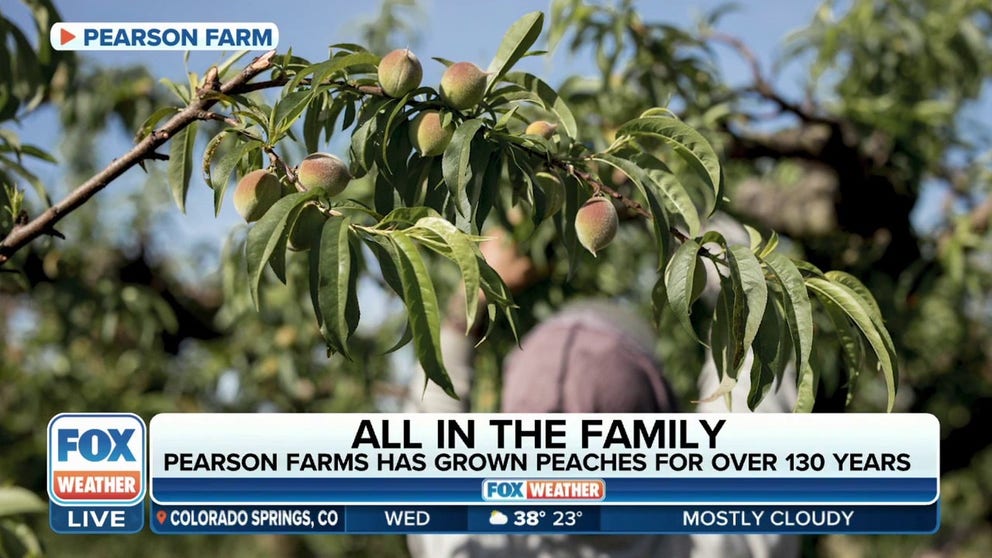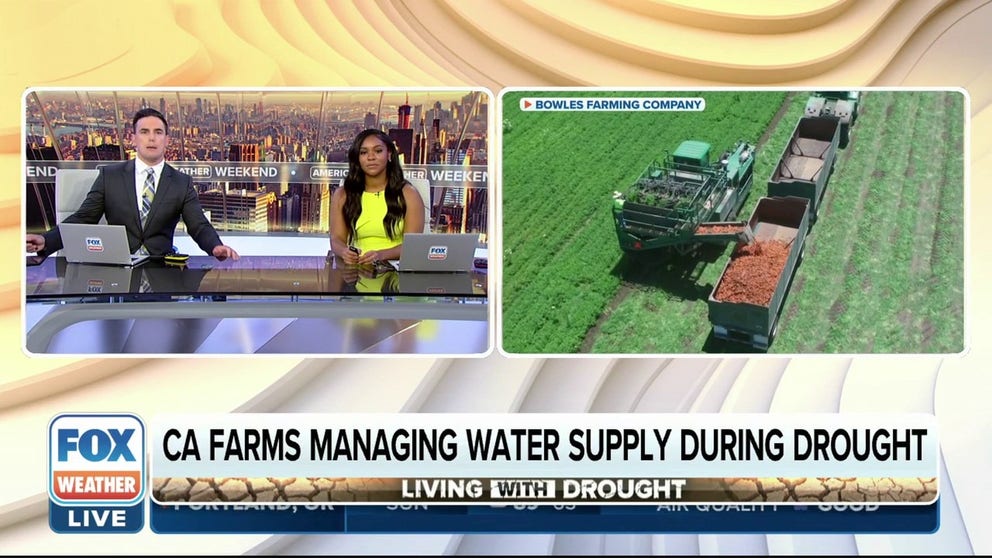What season do fruits and vegetables grow in?
California leads the nation in agricultural production with over 25 million acres of harvesting and farmland. Bananas are the most popular fruit, but few are grown in the United States. Potatoes and tomatoes are the most consumed vegetables.
Farming: No weather? No Problem.
FOX Weather's Brigit Mahoney takes a look into the next generation of farming, container farming where weather is taken out of the equation.
Agriculture is a major industry in the United States and leads to the employment of more than 10 percent of the country's workforce.
Whether it is a fruit or vegetable, the industry is at the perils of the climate, and extremes can lead to disastrous outcomes for crops and higher prices for consumers.
California leads the nation in agricultural production with over 25 million acres of harvesting and farmland.
The U.S. Department of Agriculture has a detailed map showing zones where plant hardiness is the best and where gardeners and farmers can determine which plants can be successfully harvested.
Know your planting zone: View your plant hardiness zone
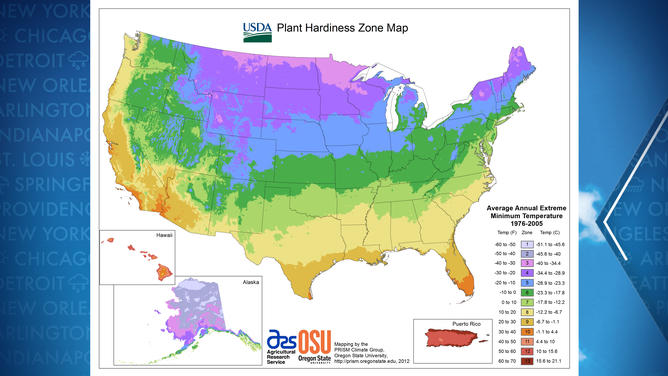
Map for gardeners and growers to determine which plants are most likely to thrive in their community.
(U.S. Department of Agriculture / FOX Weather)
HOW WEATHER AFFECTS WHAT’S ON THANKSGIVING’S MENU
Here is a breakdown of some of the most popular fruits and vegetables in the country and the potential impacts of the climate.
Apples
These usually juicy and sweet fruits are considered one of the most valuable crops in the U.S.
According to the U.S. Apple Association, around three dozen states grow commercial apples, with top producers being Washington, New York, Michigan, Pennsylvania, California, Virginia, Oregon, West Virginia and North Carolina.
According to the Agriculture Marketing Resource Center, just over 10.5 billion pounds was produced in the U.S. in 2021, with production from Washington far exceeding all other states.
Despite their popularity, the trees are not native to North America and likely originated from Eastern Europe or Western Asia.
The University of Illinois Extension office estimates there are around 2,500 varieties of apples grown across the country.
According to agricultural experts, the trees are rather complex and require a variable climate.
Each variety requires a certain amount of chilling hours, followed by warm weather, to ensure blooming and maximum growth. Temperatures of 40-45 °F are considered optimal for chilling.
Southern states are typically the first to see blooms, with sightings as early as late March or the beginning of April. Washington State’s average bloom date is late April, and northern trees, such as Minnesota or New York, usually bloom in May.
Once the blooms are pollinated, it can take about four to six months to bear fruit, which puts the harvesting season in the late summer or fall.
Growers say the trees require at least 8 hours of sun a day during the growing season, and somewhat drier weather can reduce diseases and make the fruit sweeter tasting.
MIXED BAG: APPLE PRODUCTION STILL REELING FROM HISTORIC HEAT WAVE
Avocado
Consumer demand for the fruit has significantly grown due to its health benefits.
Despite its growing popularity, zones in the country that can grow avocado trees are somewhat limited.
The climate in parts of California, Florida and Hawaii makes the states prime for production.
The California Avocado Commission says trees do the best in moderately warm climates, and as long as temperatures remain above 28 °F, they can escape cold spells with only damage.
Flowering season usually happens in the spring, but unlike many other agricultural products, it can take up to two years to develop the fruit to maturity.
Growers say trees require at least 40–50 inches of rain a year, but roots mustn’t be waterlogged to protect against disease and decay.
According to USDA data, the Golden State grows around 86% of U.S. production annually, but due to high demand, the country relies on imports to meet expectations.
In 2021, the country imported $3 billion of avocados, with 92 percent coming from Mexico.
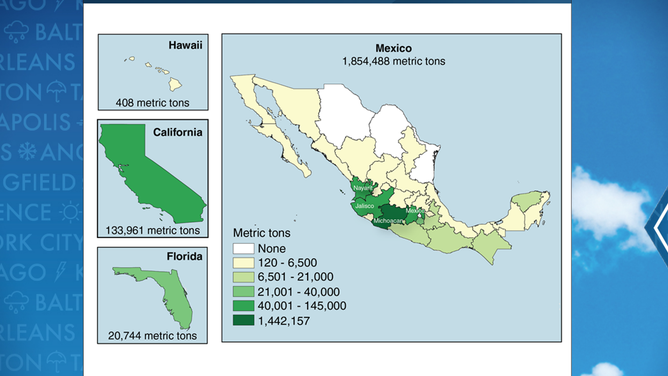
Avocado production 2018
(U.S. Department of Agriculture / FOX Weather)
Bananas
The banana is the most popular fruit in the world, but for most of the U.S., it is not a viable crop to grow.
According to agricultural experts, the plant performs the best when temperatures are at least 80 degrees and there is high humidity.
These warm standards mean Hawaii and Florida are the only two areas capable of supporting the crop.
According to the USDA, the U.S. only has around 16,000 acres of production or about 0.01% of the worldwide total.
Guatemala, Ecuador, Costa Rica, Colombia and Honduras contribute to nearly all U.S. imports.
Blueberries
These berries are native to North America and, much like avocados, are considered to be healthy due to their richness in antioxidants, vitamins and minerals.
Blueberries can grow in the wild but are commercially harvested in at least 26 states, from the East Coast to the West Coast.
The U.S. is the largest producer of blueberries and averages around 700 million pounds of the fruit.
Growers consider blueberries to be among some of the hardiest fruit plants, and if in a dormant stage, vegetation can survive temperatures as low as -20 to -30 °F.
Similar to other fruits, the plant does require several hundred hours of temperatures below 45 degrees, which are known as chill hours.
Blueberry plants typically bloom during the spring, with harvests in late summer.
In warmer climates, the blueberry season can start as early as March and last into May.
Experts say the plant grows best in full sun, and as long as there is proper irrigation, mature plants can withstand some drought conditions.
CRANBERRY INDUSTRY BOOMING AMID WILD WEATHER EXTREMES
Corn
When it comes to corn, no other country leads the world than the U.S. in production, consumption and exportation of the versatile crop.
During an average year, farmers usually produce around 90 million acres, with Iowa, Illinois, Nebraska and Minnesota leading the way.
Farming is highly dependent on climate forecasts, which can serve as a guide to when the planting season starts.
Studies show when corn is planted in late April or early May, it can lead to maximum yields, but planting is dependent on the last freeze date. Colder springs can delay the start of planting, which leads to less production.
Additionally, corn is susceptible to drought, and a lack of water can lead to lower yields and smaller kernels.
Variations of drought-resistant seeds have been developed, but only around 22 percent of the acreage planted is of a drought-tolerant variety, according to a USDA 2016 estimate.
The agency reports that most crop harvest is used for energy production and livestock feed.
‘CORN SWEAT’ IN THE MIDWEST CAN CAUSE SOME OF THE MOST OPPRESSIVE HUMIDITY IN THE US
Cranberries
This Thanksgiving Day staple is native to North America, and no other country produces more than the United States.
Cranberries are unique due to the climate patterns they require year-round, which makes the upper Midwest, Northeast and Pacific Northwest prime growing regions.
The USDA says temperatures from 60 °F to 80 °F are needed during the growing period during the spring and summer, but when the fruits mature and are near harvesting during the fall, cooler temperatures are needed to boost color and flavor.
These berries are often grown in a bog to ease farmers' harvesting and crop protection methods.
Its harvest season tends to run from mid-September to November.
Growers say during the winter off-season, it is essential that the crop sees a sufficient amount of cold weather to prevent abnormal blossoming that affects growth.
WHY DO WE EAT CRANBERRY SAUCE ON THANKSGIVING?
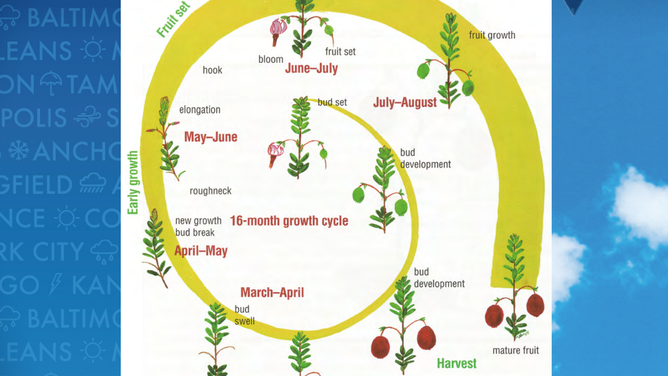
Cranberry production cycle
(Oregon State University / FOX Weather)
Grapes
Grapes are the highest-value fruit grown in the U.S., with various uses, from raisins and jellies to juices and wine.
Around 6 million tons of grapes are grown annually, and the USDA reports over 70 percent of domestic production is used for wine.
In 2021, over 95 percent of commercially grown grapes were grown in California, with the state of Washington coming in a distant second.
Growers suggest vines need warm summers and rainy winters to maximize production.
There are estimated to be over 10,000 varieties of grapes, each with a unique taste.
Grapes for wines are usually picked in August, according to Napa Valley tourism officials. Fruits designated for sparkling wines typically kick off the season, followed by white, red and cabernet.
Harvesting season can last into December, when grapes tend to be riper and have more concentrated sugars.
HOW WEATHER CAN IMPACT WINE PRODUCTION
Lettuce
Unlike many other vegetables, lettuce is considered a cool-season crop that grows best when daytime temperatures are in the 70s and nights reach the 40s.
The crop requires controlled irrigation and is sensitive to precipitation extremes.
Due to the limited temperature and rainfall range, California and Arizona make up nearly all U.S. production.
The USDA categorizes lettuce into two types: head, or iceberg, and leaf, which includes romaine, butterhead and various other leafy varieties.
California accounted for around 71 percent of U.S. head lettuce production in 2013, with Arizona producing nearly the rest. These two states also produce nearly all the leaf lettuce.
Due to the climate restrictions, growing seasons center around spring and fall.
HIGH GROCERY BILL? BLAME THE WEATHER

LOMPOC, CA - MAY 21: Despite the COVID-19 pandemic and California businesses shutdown, the state's farmers continue to plant and irrigate, in this case, lettuce, as viewed along Santa Rosa Road in Santa Barbara County on May 21, 2020, near Lompoc, California. Because of its close proximity to Southern California and Los Angeles population centers, combined with a Mediterranean climate, the rural coastal regions of Santa Barbara County have become recognized as a premium agricultural center, grape growing region, and major tourist destination.
(Photo by George Rose/Getty Images / Getty Images)
Onions
Similar to blueberries, onions are grown from coast to coast and are the fourth most consumed vegetable behind potatoes, tomatoes and corn.
According to the USDA, farmers use around 125,000 acres to produce about 6.75 billion pounds annually.
Due to their health benefits, the popularity of this vegetable continues to increase. The vegetables are known to have antioxidants and vitamins that help reduce blood sugar levels and cholesterol.
Growers say onion seeds need a temperature over 40 °F to germinate, and an optimal soil temperature is 75 °F. If optimal conditions are not met, growth will be slow.
Once the plants become established, some consider the vegetable to be drought-tolerant. Too much rainfall or watering can lead to disease and rotting.
Most onions are harvested during the summer, but growing seasons vary by region.

Onion season schedule
(National Onion Association / FOX Weather)
Oranges/Citrus
Fruits that are heavily impacted by weather extremes are the country’s orange and citrus crops.
Growing regions are susceptible to hurricanes, arctic chills, atmospheric rivers and hoist of weather events that can damage the crops and intensify diseases.
During the 2019-20 growing season, some 7.8 million tons of citrus were produced, with California leading the way, followed by Florida, Texas and Arizona.
Widespread crop harvesting in other states is limited by the trees’ lack of cold tolerance. Agricultural specialists say the optimal range for citrus is between 60 to 90 degrees.
The crops are relatively drought tolerant as too much moisture can cause significant root rot.
Due to the limited growing areas, citrus harvesting can happen nearly year around; however, summer tends to be a down season, with most production between October and June.
FLORIDA SUFFERS $1 BILLION HIT TO AGRICULTURE INDUSTRY FROM HURRICANE IAN
Peaches
Similar to apples, pears and other flowering trees, peaches require a sizable amount of cold weather to produce flowers and yield fruit.
Agricultural experts refer to time spent under a temperature threshold as chill hours, and many varieties of peaches require hundreds of hours below 45 °F to flourish.
California annually produces the majority of the peaches in the U.S. In 2017, the Golden State produced 56 percent of the county’s fresh peach crop and more than 96 percent of processed peaches. South Carolina, Georgia and New Jersey are also significant producers.
Peaches usually reach a peak in ripeness over the summer and can linger into the early fall in California.
Dario Chavez, an associate professor at the University of Georgia, believes with the increase of varieties of the fruit, some farmers are able to plant crops that do not require the amount of cold weather that some species required only a few decades ago.
"So, not long ago, they used to grow fruit that needed 900 to 1,000 chill hours. Now, they don’t grow those anymore. There are 40 to 60 varieties. So that means if you’re going to the supermarket and buying peaches, you could be buying a different variety every time," said Chavez
WILL THE LACK OF COLD WEATHER IMPACT THE PEACH HARVEST?
Georgia peach farm begins early harvest due to warm winter
Lawton Pearson, Founder and Farmer of Pearson Farm, says the warm weather this winter is forcing an early bloom of their peaches and they've begun an early harvest this season.
Potatoes
The leading vegetable in the U.S. is no other than the potato. In 2017, the government said the county exported potato products valued at over $3 billion.
Much like lettuce, potatoes are a cool-season crop and are almost exclusively grown in Idaho and Washington.
The Washington State Potato Commission says the planting season can start as early as March and run to May.
Experts say the ideal temperature for growth is when lows are in the 50s and 60s and highs stay below 80 degrees. Wet soils can increase decay and delay sprouting.
Because it is a root vegetable, the higher altitudes and nearly full sun are not hindrances for this vegetable.
Depending on the variety, harvests can start in July and run through October.
Due to how labor-intensive potato farming is, operations are a year-long process.
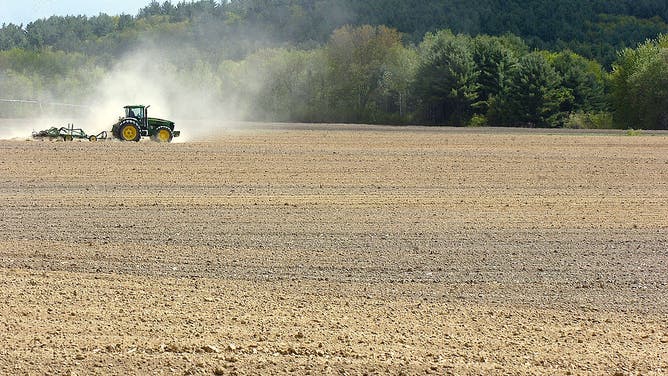
John Ewing/Staff Photographer: -- Monday, May 19, 2008 -- High-tech farming techniques utilizing GPS technology are allowing potato farms such as the Green Thumb Farm in West Fryeburg to increase production. A tractor kicks up a cloud of dust as it prepares a field for planting of potato seed at the farm.
(photo by John Ewing/Portland Press Herald via Getty Images / Getty Images)
Pumpkins
A fruit that signifies the changing of the season more than any other is the fall pumpkin.
Despite conventional thinking, the pumpkin is a fruit, not a vegetable. This is due to the crop starting from a flower versus a seed.
Pumpkins are native to North America and are typically planted in the late spring to early summer.
The crop is primarily grown in the country’s northern tier due to the heat and extremes that can be common throughout the South.
The Illinois Specialty Growers Association said the crop is highly susceptible to extreme temperatures and rain. Too much precipitation can cause rotting and even disease. On the opposite side of the spectrum, a severe lack of rainfall can lead to more miniature pumpkins.
The Prairie State is the leader in pumpkin production, with about 80 percent of crops used in processed pumpkins and 20 percent designated for ornamental uses.
Agricultural experts say if one of the growing regions has a below-average season, other states can usually make up for the shortfall.
HERE’S WHAT TO DO WITH YOUR OLD PUMPKINS
Strawberries
A heart-shaped fruit that is the favorite of millions is also vulnerable to extreme weather events from coast-to-coast.
The U.S. Department of Agriculture reports California and Florida annually produce a combined total of 98 percent of domestic production, with the Golden State accounting for the vast majority of more than 2 billion pounds of the crop.
Heavy rainfall events and cold temperatures can harm the plants and make them difficult to recover from during the season.
Strawberries in Florida are planted in the fall, and fruit grows into April or May. In California, peak planting and growing seasons usually occur in the spring and run through the fall.
Strawberries are not drought-tolerant but do not grow when over-watered.
STRAWBERRY OUTLOOK DEEMED ‘PROMISING’ DESPITE IMPACTS FROM HURRICANES, ATMOSPHERIC RIVERS
Tomatoes
The U.S. is one of the world leaders in tomato production, and around 3 billion pounds of fresh tomatoes are grown annually.
Agriculture experts say California and Florida lead the pack due to the warm climate.
In the Golden State, tomatoes are usually harvested in the spring, summer and fall, with Florida production peaking in the winter and spring.
Tomatoes require temperatures to remain above 60 °F. Once the mercury drops below the crucial threshold, development can be slow, and the fruits can become deformed.
Due to the ease of growing the crop and limited land needed for operation, greenhouses are becoming more popular for tomatoes.
The USDA reports recent development of greenhouses in Nebraska, Minnesota, New York and other states have increased market across, especially during the off-season, and improved yields.
SHE’S PERHAPS THE OLDEST LOBSTERWOMAN IN THE WORLD: MEET 102-YEAR-OLD VIRGINIA OLIVE
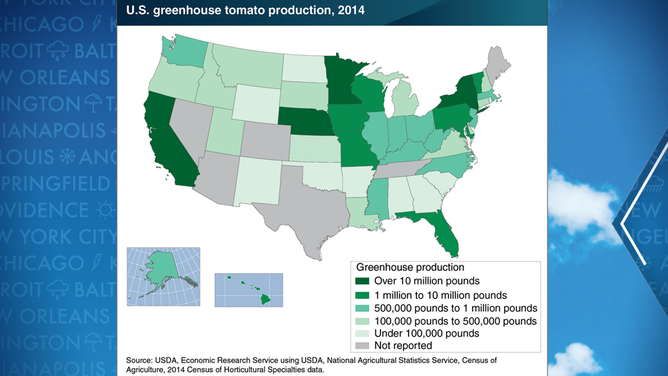
US tomato greenhouse production
(FOX Weather)
Watermelon
Like avocados, the U.S. must import watermelons to keep up with demand.
Most of the county’s 4 billion pounds of watermelon come from the states of Florida, Georgia, Texas and California.
The country requires millions of additional pounds of watermelons from other countries to meet consumer demand. The USDA reports in 2019, 1.7 billion pounds of watermelons were imported, with Mexico supplying around 80 percent.
Penn State agriculture experts say watermelons are extremely sensitive to cold weather. Thus, only southern states and California are regions where it widely grows.
The plants need a reasonably warm soil temperature to grow and farmers look for air temperatures to be between 65 °F to 95 °F. Temperatures outside this range can impact the growth of the crop.
The fruit is 92 percent water, and growing soil requires sufficient irrigation in the top 12 inches of soils, where roots are located.
Harvesting season usually peaks in the summer and winds down by the fall.
NOT GETTING ENOUGH WATER? EAT IT WITH THESE HYDRATING FOODS
Fewer tomatoes, onions and watermelons due to drought
Western farms cut down on the number of acres of family grocery store staples due to drought. Derek Azevedo of Bowles Farming Company in California explains why dry conditions mean fewer tomatoes, almonds, bell peppers and onions.
Wheat
The U.S. is one of the many countries considered to be the breadbox of the world and produces about 50 million acres of wheat each year.
If soils are well drained, the USDA says the crop can grow in nearly every state. Wheat does have a maximum temperature in the 90s, which prevents many Southeast states from being large producers.
Unlike many other fruits and vegetables, wheat has several growing seasons.
Winter wheat is planted in the fall and is harvested in the late spring and early summer. Spring wheat is typically planted after the last snowfall in April and May and is harvested in the late summer and early fall.
Snow is considered to be necessary to farmers because it can eliminate damaging insects and diseases and provide plenty of moisture during the melting season.
A warmer winter has resulted in lower yields and limited root development.
WEATHER, RUSSIA-UKRAINE CONFLICT LEADING TO SKYROCKETING WHEAT PRICES
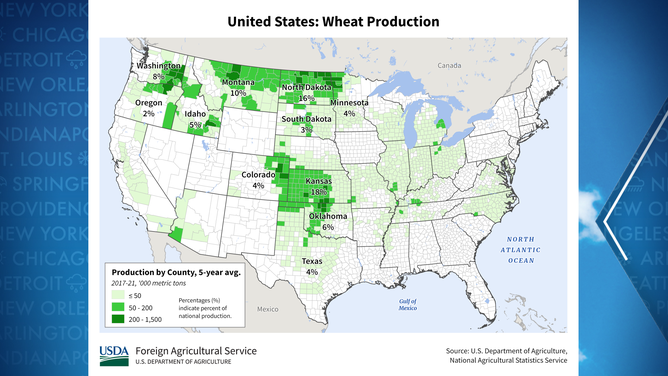
US wheat production map
(USDA / FOX Weather)
